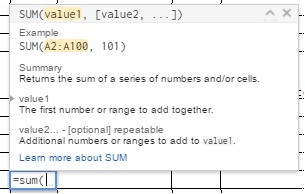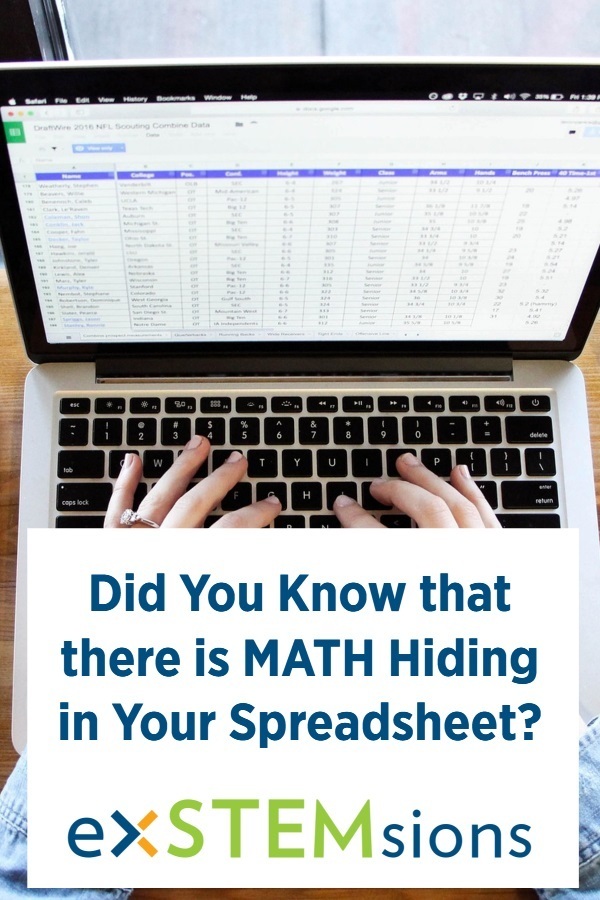Did You Know There's Math Hiding in Your Spreadsheet?

How do you use Excel?
My colleagues (past and present) often make fun of me - I have an Excel spreadsheet for just about everything. Mostly, I use them to keep track of information - my wedding guest list, addresses, spending, blog posts, and whatever else I might need to make a list of. Sometimes, I even use Excel the way it was really intended, to calculate things (like my checkbook!). My husband also uses Excel for everything, but in a totally different way. He primarily uses it to make big, complex calculations (although, he has also been known to open a spreadsheet to add), and write formulas that help him to make graphs, analyze data and all kinds of other things. He uses them for work, but also for sports - he actually has a very fancy spreadsheet to help him analyze his golf game.
Excel is math?
Why are we talking about this? One of our recent problems, where we analyzed a series of equations looking for an error in calculation, made me think of it. My husband uses Excel ALL the time and in using Excel, he does a TON of math. But he has no idea that he’s doing it. Excel is amazing, because it essentially enables all kinds of people to do calculus, statistics, and complex computations without ever knowing it’s happening. The thing with Excel is that it depends on the user to input arithmetic correctly. When things go wrong, it’s often a simple step in the arithmetic that went haywire, just like in our problem, with one small error creating a weird end result.
Have you ever written a formula in Excel? If you have, you’ll know that as you input the numbers into the formula, Excel gives you little directions that explain which numbers/what information to put where. For example, if I want to find the sum of a bunch of numbers in a column or row, I type “=sum(start cell:end cell)”, hit return and Voila! Sums! The directions look like this (look at the top row):

Sums are easy; in this case, it’s just a faster way to do something we all know how to do, which is add a whole bunch of numbers together. But if you type = into a cell, and then a letter, say “m”, you’ll see a whole list of other things you can do, like find the minimum, the maximum, the mode, the median...all kinds of things that you could use to help you analyze information. And that’s just “m”! So in Excel, you can do all sorts of math with numbers you have in a list, and you can write formulas that combine things together.

Spreadsheets are filled with math!
This is what my husband does. And as I said earlier, he’s doing all sorts of math. When I ask him if he gets that - that Excel is really cool math - the answer is generally, ‘well, no, it’s just Excel. I GET Excel. I don’t always GET math.’ This is where we get into trouble. Sometimes, like in the problem with the equations where there was an error, not recognizing the math in the formulas causes a problem. It means that he and his colleagues/golf friends can’t find the errors in their formulas when things go wrong. We’ve been married a while now (more than 13 years!) and over the time we’ve known each other, from dating to now, I’ve gotten more than a handful of phone calls that sound like this:
Husband: “Hi Sara, do you have a pen?”
Me: “Sure. Why?”
Husband: “Here is my formula: [complex formula]. It doesn’t work. What’s wrong with it?”
Me: “Well, what do you want it to do?”
Husband: “It’s supposed to find ____, but it doesn’t.”
Me: “Ah, well...hmmm….[looking]. Well, usually the rules say you shouldn’t do ____ like that...did you mean to do ____ that way?’
Husband: “Ah-HA! Bye!”
So maybe you are like my husband, and use, like, or even LOVE Excel. If so, congratulations, you are a secret math geek :) Excel enables you to do lots of complicated math - you just don’t know it! Next time you write a formula, take a minute to really think about it. Try to give the formula context - why are these the numbers I’m putting in, and what’s happening to them that lets Excel give me the right result? Doing this will not only have you writing better formulas, but you’ll start seeing the math you’ve been doing all along, without even realizing it.
Enjoy this blog? Don't forget to follow us using the links at the top of the page, and have new posts delivered right to your inbox!
Want awesome tips and a mini-challenge, all designed to help you build vital problem-solving and critical thinking skills in your child? Click here to sign up for our monthly newsletter!



